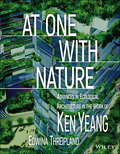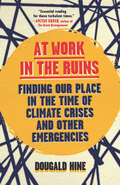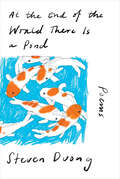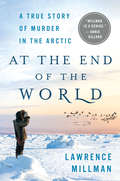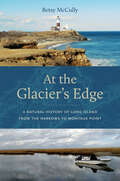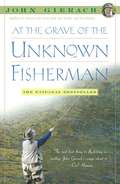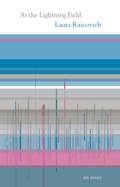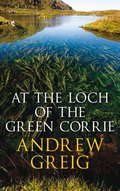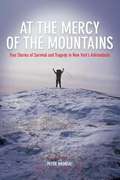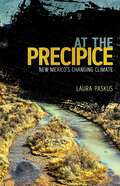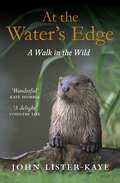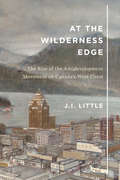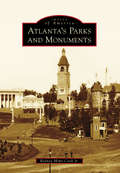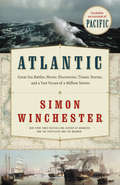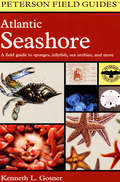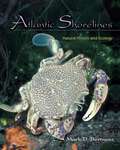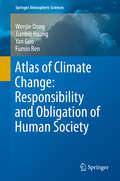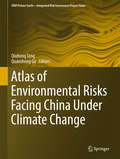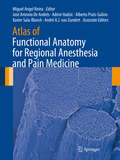- Table View
- List View
At Home with Plants
by Ian Drummond Kara O'Reilly***A stylish addition to the current craze for indoor greenery, this is as much about how you use plants as an integral part of contemporary decor as how to keep them alive and well. - The Sunday TimesHouseplants are hot, and creative interior planting is becoming increasingly easy to achieve. The new wave of unusual and dramatic indoor plants is as much about décor and statement as greenery. Used aesthetically, as a focal point and sculptural element in interior design, indoor gardening is not just about possessing or growing a plant, but about using it as an accessory combined with other objects to create a particular style and mood. In this much-needed book, now reissued with a new cover and updated source directory, Ian and Kara show you how to transform your home with plants and tells you which plants will work best where and how to care for them. From strikingly geometric terrariums to pretty hanging baskets, practical herb pots and colourful window displays, this book is packed full of exciting and gorgeous ideas. Specially commissioned photography by Nick Pope throughout proves that bringing the outdoors in really is the best form of interior design.
At One with Nature: Advances in Ecological Architecture in the Work of Ken Yeang
by Ken Yeang Edwina Threipland"At One with Nature is an inspiring collection of the latest work of Ken Yeang that further advances sustainable architecture and design. This collection features recent projects as he explores how we can achieve harmony between the natural and our built environments to create a better planet by design. Each project features and highlights not only the systems and devices adopted, but also outlines the intentions and ecological considerations demonstrating best practices for how we can proceed moving forward. The book role models our living Earth and shows how we can behave as stewards of our planet."--Cassia Patel, Oceanic Global Foundation At One with Nature showcases Ken Yeang's latest ideas, built projects designs, research work and advances in the field of designing with nature, a topic that Yeang has pioneered and developed over many decades since receiving his doctorate in ecological design and planning from Cambridge University. His ideas and work are even more pertinent today with the current state of devastation of Earth's natural systems and a biogeochemical cycle that has been extensively and severely impacted by human society. The global environment today is in a state of crisis, but what can society do to address the issues? Yeang's recent projects are presented with instructive diagrams that provide a basis for action for architects, planners, designers, engineers, and anyone whose daily work impinges on the natural environment. Offered in a highly visual, annotated format, with instructive illustrations of Yeang's theoretical books on the topic, At One with Nature is an invaluable resource that students and academics interested in designing with nature will find both informative and relevant.
At Work in the Ruins: Finding Our Place in the Time of Climate Crises and Other Emergencies
by Dougald Hine&‘One of the most perceptive and thought-provoking books …Essential reading for these turbulent times.&’ Amitav Ghosh, author of The Great Derangement&‘Dougald Hine&’s brilliant book demands we stare into that abyss and rethink our securest certainties about what is actually going on in the climate crisis. It&’s lucidly unsettling and yet in the end empowering. There is something we can do, and it starts with where we look, how we see and what we choose to change.&’ Brian Eno, Musician&‘[A] rich book, which like a poetic or religious text deserves multiple readings&’ Richard Smith, British Medical Journal&‘I consider this book a must-read for all those activists feeling lost, desperate and perhaps subject to &‘press-on-itis&’.&’ Gail Bradbrook, cofounder, Extinction RebellionDougald Hine, world-renowned environmental thinker, has spent most of his life talking to people about climate change. And then one afternoon in the second year of the pandemic, he found he had nothing left to say. Why would someone who cares so deeply about ecological destruction want to stop talking about climate change now? At Work in the Ruins explores that question.&‘Climate change asks us questions that climate science cannot answer,&’ Dougald says. Questions like, how did we end up in this mess? Is it just a piece of bad luck with atmospheric chemistry – or is it the result of a way of approaching the world that would always have brought us to such a pass? How we answer such questions also has consequences.Through our over-reliance on the single lens of science, Dougald writes that we are blinded to the nature of the crises around and ahead of us, leading to &‘solutions&’ that can only make things worse. At Work in the Ruins is his reckoning with the strange years we have been living through and our long history of asking too much of science. He offers guidance by standing firmly forward and facing the depth of the trouble we are in, to ultimately, helps us find the work that is worth doing, even in the ruins.
At the End of the World There Is a Pond: Poems
by Steven DuongA stunning debut volume infused with apocalyptic overload, beginnings and endings, and all the ways we betray ourselves. At the End of the World There Is a Pond is a book about aftermaths. Each poem comes in the wake of a deep rupture—the ruptures of mental illness and addiction, of migration and displacement, of violence, familial conflict, and ecological catastrophe—and yet the speakers engage with despair and playfulness in equal measure, always allowing humor, irony, and the exuberance of contemporary life to bend darkness toward something like hope. Again and again, Steven Duong’s writing excavates the unnatural conditions of a seemingly natural world, asking us to pay studied attention to its inhabitants. His poems force us to keep looking: at the betta fish trapped in its mason jar, the forest choked by invasive kudzu, the elephant wounded in a landmine blast. Through its relentless scrutiny and exacting care, this magisterial debut collection poses an impossible question: How can we reconcile a deep love for the world, in all its buzzing, wriggling aliveness, with an equally deep, self-destructive desire to leave it behind?
At the End of the World: A True Story of Murder in the Arctic
by Lawrence MillmanAt the End of the World is the remarkable story of a series of murders that occurred in an extremely remote corner of the Arctic in 1941. Those murders show that senseless violence in the name of religion is not only a contemporary phenomenon, and that a people as seemingly peaceful as the Inuit can become unpeaceful at the drop of a hat or, in this instance, a meteor shower. At the same time, the book is a warning cry against the destruction of what’s left of our culture’s humanity, along the destruction of the natural world. Has technology deprived us of our eyes? the author asks. Has it deprived the world of birds, beasts, and flowers? Lawrence Millman's At the End of the World is a brilliant and original book by one of the boldest writers of our era.
At the Glacier’s Edge: A Natural History of Long Island from the Narrows to Montauk Point
by Betsy McCullyVast salt marshes, ancient grasslands, lush forests, pristine beaches and dunes, and copious inland waters, all surrounded by a teeming sea. These are probably not the first things you imagine when you think of Long Island, but just beyond its highways and housing developments lies a stunning landscape full of diverse plant and animal life. Combining science writing, environmental history, and first-hand accounts from a longtime resident, At the Glacier’s Edge offers a unique narrative natural history of Long Island. Betsy McCully tells the story of how the island was formed at the end of the last ice age, how its habitats evolved, and how humans in the last few hundred years have radically altered and degraded its landscape. Yet as she personally recounts the habitat losses and species declines she has witnessed over the past few decades, she describes the vital efforts that environmental activists are making to restore and reclaim this land—from replanting salt marshes, to preserving remaining grasslands and forests, to cleaning up the waters. At the Glacier’s Edge provides an in-depth look at the flora, fauna and geology that make Long Island so special.
At the Grave of the Unknown Fisherman
by John GierachAt the Grave of the Unknown Fisherman is a journey through the year with America's finest fishing writer, John Gierach. The journey begins with an early spring expedition to Wyoming, where the dirt roads are still covered with a thin sheen of ice that quickly turns to mud underfoot. The conditions are so uninviting that everyone involved agrees they must be crazy to be fishing so early in the season. But, as Gierach observes, "nothing makes a fisherman happier than to have just proved that he must be crazy. " Gierach's fishing year ends with a winter fly-fishing trip in the Colorado Rockies, a time of year when, Gierach says, "it's still possible to have what seems like a whole river all to yourself. " Of course, the chances of catching any fish are small, a situation about which Gierach comments, "Anyone would go fishing thinking he'll catch something. It's when you go figuring you probably won't that you know you've crossed some kind of line. "In between, Gierach entertains us as always, mixing the one-liners about the fishing life with deeper insights into friendship, how we spend our time, and why nature still matters to us. At the Grave of the Unknown Fisherman contains Gierach's trademark blend of humor and acuity. Comparing trout and carp, he says, "If you wanted a fish that could sip white wine and discuss Italian poetry, you'd look for a trout. If you needed a ditch dug, you'd hire a carp. " Commenting on the value of a good map, he observes, "It seems like I've spent half my life trying to locate myself on maps, either just out of curiosity or to answer specific questions like Where the hell am I?' and 'How do I get out of here?' Gierach offers his opinions on the etiquette of sharing secret fishing spots, the ethics of lying to protect these spots, the secretive subculture of bamboo rods, and many other topics important to fishermen everywhere. Above all, however, Gierach understands that the real pleasure in fishing is greater than the sum of its accessories. He describes fish, mountain streams, birch thickets, and the joy of a beautiful day outdoors with a naturalist's eye and appreciation. And he understands fishing like the sage observer that he is: Fishing is one of the few ways I know of to let go of the past, forget about the future, and live in the moment. "Keenly observed and wryly recorded as always, John Gierach's latest book of fishing adventures and misadventures is sure to be enjoyed by anyone who fishes -- and everyone who wishes he fished more.
At the Heart of the Coral Triangle: Celebrating Biodiversity
by Alan J Powderham Sancia van der MeijThe Coral Triangle, straddling the confluence of the Indian and Pacific Oceans, harbours the greatest biodiversity of marine life on the planet. It is home to a wondrous variety, including 75% of the world's coral species and around 2500 species of fish. The biological and environmental diversity is driven by the volcanically active and complex geology of the so called 'Ring of Fire'. Habitats range from underwater slopes of volcanic black sand to extensive coral reefs in atolls and vast calderas. While clearly vulnerable to increasing global threats such as climate change, pollution and overfishing, the Coral Triangle currently features some the richest coral reefs in the world. With stunning photography supported by an engaging and accessible text, this book highlights and celebrates this biodiversity along with the underlying message that it needs our care and protection before it is too late.
At the Lightning Field
by Laura RaicovichWalter De Maria's "Lightning Field" is 400 stainless steel poles, positioned 220 feet apart, in the desert of central New Mexico. Over the course of several visits, it becomes, for Raicovich, a site for confounding and revealing perceptions of time, space, duration, and light; how changeable they are, while staying the same.
At the Loch of the Green Corrie
by Andrew GreigA homage to a remarkable poet and his world.'At The Loch of Green Corrie is more than merely elegant, more than a collection of albeit fascinating insights, laugh-out-loud observations and impressively broad erudition' - Sunday Herald'You could easily make a case that Andrew Greig has the greatest range of any living Scottish writer' - ScotsmanFor many years Andrew Greig saw the poet Norman MacCaig as a father figure. Months before his death, MacCaig's enigmatic final request to Greig was that he fish for him at the Loch of the Green Corrie; the location, even the real name of his destination was more mysterious still. His search took in days of outdoor living, meetings, and fishing with friends in the remote hill lochs of far North-West Scotland. It led, finally, to the waters of the Green Corrie, which would come to reflect Greig's own life, his thoughts on poetry, geology and land ownership in the Highlands and the ambiguous roles of whisky, love and male friendship. At the Loch of the Green Corrie is a richly atmospheric narrative, a celebration of losing and recovering oneself in a unique landscape, the consideration of a particular culture, and a homage to a remarkable poet and his world.
At the Loch of the Green Corrie
by Andrew GreigA homage to a remarkable poet and his world.'At The Loch of Green Corrie is more than merely elegant, more than a collection of albeit fascinating insights, laugh-out-loud observations and impressively broad erudition' - Sunday Herald'You could easily make a case that Andrew Greig has the greatest range of any living Scottish writer' - ScotsmanFor many years Andrew Greig saw the poet Norman MacCaig as a father figure. Months before his death, MacCaig's enigmatic final request to Greig was that he fish for him at the Loch of the Green Corrie; the location, even the real name of his destination was more mysterious still. His search took in days of outdoor living, meetings, and fishing with friends in the remote hill lochs of far North-West Scotland. It led, finally, to the waters of the Green Corrie, which would come to reflect Greig's own life, his thoughts on poetry, geology and land ownership in the Highlands and the ambiguous roles of whisky, love and male friendship. At the Loch of the Green Corrie is a richly atmospheric narrative, a celebration of losing and recovering oneself in a unique landscape, the consideration of a particular culture, and a homage to a remarkable poet and his world.
At the Mercy of The Mountains: True Stories of Survival and Tragedy In New York's Adirondacks
by Peter BronskiIn this compelling book, award-winning adventure writer and former Lower Adirondack Search and Rescue team member Peter Bronski chronicles true stories of survival and tragedy, from famous historical cases during the early 20th century, to modern tales of harrowing struggle in the mountains and wilderness. Extensively researched, these gripping tales pull together historical accounts, first-hand interviews, previously untold stories and expert analysis to retrace each misadventure
At the Precipice: New Mexico's Changing Climate
by Laura PaskusAt the Precipice explores the question many of us have asked ourselves: What kind of world are we leaving to our children? The realities of climate change consume the media and keep us up at night worrying about the future. But in New Mexico and the larger Southwest, climate change has been silently wreaking havoc: average temperatures in the Upper Rio Grande Basin are increasing at double the global average, super fires like Las Conchas have devastated mountains, and sections of the Rio Grande are drying up.Laura Paskus has tracked the issues of climate change at both the state and federal levels. She shares the frightening truth, both in terms of what is happening in nature and what is not happening to counteract the mounting crisis. She writes, &“I wonder about the coming world. Which trees will grow, which birds will have survived. . . . The door to that new world has opened. And there&’s no going back.&” And yet our future is not yet determined—or is it?
At the Root of It
by Robert NewellWhat grow underground and are strong enough to break through rock? The answer is roots. Roots are an amazing part of plants and trees. At the Root of It explains how roots work hard so plants and trees survive and grow.
At the Water's Edge: A Walk in the Wild
by John Lister-KayeFor the last thirty years John Lister-Kaye, one of Britain's best-known nature writers, has taken the same circular walk from his home deep in a Scottish glen up to a small hill loch. Each day brings a new observation or an unexpected encounter - a fragile spider's web, an osprey struggling to lift a trout from the water or a woodcock exquisitely camouflaged on her nest - and every day, on his return home, he records his thoughts in a journal.Drawing on this lifetime of close observation, John Lister-Kaye's new book encourages us to look again at the nature around us and to discover its wildness for ourselves. It also forges wonderful connections between the most unlikely subjects, from photosynthesis and the energy cycle to Norse mythology, to weasels and perfume and to the over-population of our planet.At the Water's Edge is a lyrical hymn to the wildlife of Britain, and a powerful warning to respect and protect it.
At the Wilderness Edge: The Rise of the Antidevelopment Movement on Canada's West Coast (McGill-Queen's Rural, Wildland, and Resource Studies #11)
by J. I. LittleVancouver prides itself on being a green city, and the west coast is known for its active environmental protest culture. But the roots of this mentality reach far beyond the founding of organizations such as Greenpeace. Small campaigns led by local community groups from the 1960s onward left a lasting impact on the region. At the Wilderness Edge examines five antidevelopment campaigns in and around Vancouver that reflected a dramatic decline in public support for large-scale commercial and industrial projects. J.I. Little describes the highly effective protests that were instrumental in preserving threatened green spaces on Coal Harbour, Hollyburn Ridge, Bowen Island, Gambier Island, and the Squamish estuary, keeping these important British Columbia landmarks from becoming a high-rise development project, a downhill ski resort, a suburban housing tract, an open-pit copper mine, and a major coal port, respectively. Through detailed analysis of development proposals and protests, government studies, and community responses, Little argues that it was not the usual suspects – 1960s radicalism and anti-establishment youth culture – that initiated and carried out these protests, but rather middle-aged, middle-class, politically engaged citizens, many of whom were women. An engaging study of grassroots politics in action, At the Wilderness Edge sheds new light on the rise of environmental consciousness, a pivotal era in the history of British Columbia, the Pacific Northwest, and Canada.
Atlanta's Parks and Monuments
by Rodney Mims Cook Jr.Since the city's beginnings after the War of 1812, Atlanta has had a tradition of building with a regard for becoming a world-class metropolis. Before being burned by Union general William T. Sherman in 1864, the city's appearance was described by noted European architect and urban planner Leon Krier as "looking like London in the 18th century." Atlanta was surrounded by estates and plantations, and many of the plantation builders were influenced by Greek and Roman architecture. The argument of slavery to the contrary, builders saw Greek temples as symbols of democracy and, as a result, embraced Greek and Roman revival architecture as the dominant national style. Great monuments followed in this tradition to the letter in the capital of the South.
Atlantic
by Simon WinchesterBlending history and anecdote, geography and reminiscence, science and exposition, the New York Times bestselling author of Krakatoa tells the breathtaking saga of the magnificent Atlantic Ocean, setting it against the backdrop of mankind's intellectual evolution Until a thousand years ago, no humans ventured into the Atlantic or imagined traversing its vast infinity. But once the first daring mariners successfully navigated to far shores-whether it was the Vikings, the Irish, the Chinese, Christopher Columbus in the north, or the Portuguese and the Spanish in the south-the Atlantic evolved in the world's growing consciousness of itself as an enclosed body of water bounded by the Americas to the West, and by Europe and Africa to the East. Atlantic is a biography of this immense space, of a sea which has defined and determined so much about the lives of the millions who live beside or near its tens of thousands of miles of coast. The Atlantic has been central to the ambitions of explorers, scientists and warriors, and it continues to affect our character, attitudes, and dreams. Poets to potentates, seers to sailors, fishermen to foresters-all have a relationship with this great body of blue-green sea and regard her as friend or foe, adversary or ally, depending on circumstance or fortune. Simon Winchester chronicles that relationship, making the Atlantic come vividly alive. Spanning from the earth's geological origins to the age of exploration, World War II battles to modern pollution, his narrative is epic and awe-inspiring.
Atlantic High: A Celebration
by William F. Buckley Jr.William F. Buckley Jr.'s account of his voyage across the Atlantic Ocean in the sailboat Sealestial, Atlantic High is a work that everywhere evidences Buckley's love for sailing and good companionship. Infused with his inimitable wit and supported by a rich fund of anecdotes and observations, Atlantic High is truly a one-of-a-kind work.
Atlantic Seashore: A Field Guide to Sponges, Jellyfish, Sea Urchins, and More (Peterson Field Guides #Vol. 24)
by Kenneth L. GosnerExplore the shore with this beautifully illustrated nature guide! Using the renowned Peterson Identification System, this easy-to-use guide, sponsored by the National Audubon Society, the National Wildlife Federation, and the Roger Tory Peterson Institute, is the perfect companion for exploring the seashore. More than one thousand illustrations, arranged according to visual similarities, show plant and animal species of the Atlantic Coast from the Bay of Fundy to Cape Hatteras. This guide includes information on how to locate each species by geographic range, tidal range, tidal level, season, topography, and climate.
Atlantic Shorelines: Natural History and Ecology
by Mark D. BertnessA comprehensive introduction to the natural history and intertidal ecology of East Coast shorelinesAtlantic Shorelines is an introduction to the natural history and ecology of shoreline communities on the East Coast of North America. Writing for a broad audience, Mark Bertness examines how distinctive communities of plants and animals are generated on rocky shores and in salt marshes, mangroves, and soft sediment beaches on Atlantic shorelines.The book provides a comprehensive background for understanding the basic principles of intertidal ecology and the unique conditions faced by intertidal organisms. It describes the history of the Atlantic Coast, tides, and near-shore oceanographic processes that influence shoreline organisms; explains primary production in shoreline systems, intertidal food webs, and the way intertidal organisms survive; sets out the unusual reproductive challenges of living in an intertidal habitat, and the role of recruitment in shaping intertidal communities; and outlines how biological processes like competition, predation, facilitation, and ecosystem engineering generate the spatial structure of intertidal communities.The last part of the book focuses on the ecology of the three main shoreline habitats—rocky shores, soft sediment beaches, and shorelines vegetated with salt marsh plants and mangroves—and discusses in detail conservation issues associated with each of them.
Atlantic World: A History, 1400-1888
by Donald R. Wright Douglas R. Egerton Alison Games Kris E. Lane Jane G. LandersBefore the voyage of Columbus in 1492, the Atlantic Ocean stood as a barrier to contact between the people (and their ideas and institutions), plants, animals, and microbes of Eurasia and Africa on the one hand and the Americas on the other. Following Columbus's voyage, the Atlantic turned into a conduit for transferring these things among the four continents bordering the ocean in ways that affected people living on each of them. The appearance of The Atlantic World marks an important achievement, for it stands out as the first successful attempt to combine the many strains of Atlantic history into a comprehensive, thoughtful narrative. At the core of this ground-breaking and eloquently written survey lies a consideration of the relationships among people living in Europe, Africa, and the Americas, with a focus on how these relationships played important roles--often the most important roles--in how the histories of the people involved unfolded. The ways of life of millions of people changed, sometimes for the better but often for the worse, because of their relationship to the larger Atlantic world. And unlike existing texts dealing with one or another aspect of Atlantic history, The Atlantic World does not subjugate the history of Africa and South America to those of the "British Atlantic" or Europe. With historians and other scholars beginning to reconceptualize the Atlantic World as a dynamic zone of exchange in which people, commodities, and ideas circulated from the mid-fifteenth century until the dawn of the twentieth century, the interconnections between people along the Atlantic rim create a coherent region, one in which events in one corner inevitably altered the course of history in another. As this book testifies, Atlantic history, properly understood, is history without borders--in which national narratives take backstage to the larger examination of interdependence and cultural transmission. Conceived of and produced by a team of distinguished authors with countless hours of teaching experience at the college level, this thoughtfully organized, beautifully written, and lavishly illustrated book will set the standard for all future surveys intended as a core text for the new and rapidly growing courses in Atlantic History.
Atlas of Climate Change: Responsibility and Obligation of Human Society (Springer Atmospheric Sciences)
by Fumin Ren Jianbin Huang Wenjie Dong Yan GuoThis atlas and reference resource assembles the latest research findings on the responsibility and obligation of human society for historical climate change. It clearly and quantitatively estimates to what extent the developed and developing world are responsible for historical climate change with regard to anthropogenic carbon and sulfur emissions as well as global carbon trade, and so provides a potential tool to address the controversial issue of carbon emission reduction in international climate negotiations. Since the quantitative attribution of historical climate change is calculated based on CMIP5 models, the fidelity of these models in representing the observed climate change is also evaluated. In addition to evaluation, future climate change based on CMIP5 models is also shown both on global and regional scales (especially for China and its surrounding areas ) in terms of surface air temperature, precipitation, sea surface temperature, atmospheric circulations and Arctic Sea ice. The atlas also makes various comparisons among different multi-model ensemble methods in order to obtain the most reliable estimation.
Atlas of Environmental Risks Facing China Under Climate Change (IHDP/Future Earth-Integrated Risk Governance Project Series)
by Qiuhong Tang Quansheng GeThis atlas provides the most comprehensive and accurate overview of environmental risks relating to climate change vulnerability and adaptation in China. It addresses the agricultural, ecosystem and heat wave health risk posed by climate change and presents the projected environmental risks in the 21st century under climate change and socioeconomic scenarios. The detailed and concise risk assessments are mapped in grid units, allowing easy environmental risk assessment for specific locations. The atlas contributes significantly to the knowledge base for climate change adaptation in China and is a valuable resource for students and professionals in the fields of geographic sciences and climate change.
Atlas of Functional Anatomy for Regional Anesthesia and Pain Medicine: Human Structure, Ultrastructure and 3D Reconstruction Images
by Miguel Angel Reina José Antonio De Andrés Admir Hadzic Alberto Prats-Galino Xavier Sala-Blanch André A.J. van ZundertThis is the first atlas to depict in high-resolution images the fine structure of the spinal canal, the nervous plexuses, and the peripheral nerves in relation to clinical practice. The Atlas of Functional Anatomy for Regional Anesthesia and Pain Medicine contains more than 1500 images of unsurpassed quality, most of which have never been published, including scanning electron microscopy images of neuronal ultrastructures, macroscopic sectional anatomy, and three-dimensional images reconstructed from patient imaging studies. Each chapter begins with a short introduction on the covered subject but then allows the images to embody the rest of the work; detailed text accompanies figures to guide readers through anatomy, providing evidence-based, clinically relevant information. Beyond clinically relevant anatomy, the book features regional anesthesia equipment (needles, catheters, surgical gloves) and overview of some cutting edge research instruments (e. g. scanning electron microscopy and transmission electron microscopy). Of interest to regional anesthesiologists, interventional pain physicians, and surgeons, this compendium is meant to complement texts that do not have this type of graphic material in the subjects of regional anesthesia, interventional pain management, and surgical techniques of the spine or peripheral nerves.

